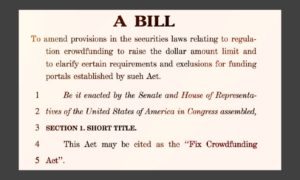
In early June, the U.S. House of Representatives, Financial Services Committee, approved the “Fix Crowdfunding Act” bill (HR 4855). Maybe it’s the title of the bill that is misleading, but since then I have seen multiple articles which incorrectly describe what this legislation, if fully passed, would do. As a result, I felt it necessary to do a detailed review of the bill itself to point out what it actually does and what it does not.
 The Fix Crowdfunding Act, sponsored by Congressman Patrick McHenry, passed the House by a vote of 394-4. This bill was originally put forward to increase the utility of Title III (or Regulation CF) investment crowdfunding rules by proposing fixes to five (5) of the major perceived intrinsic shortcomings in the final Title III rules. However, what many people who are currently writing articles on the subject fail to recognize is that the bill was significantly amended prior to it being passed by the House, and what was actually passed represents only a fraction of what was originally asked for.
The Fix Crowdfunding Act, sponsored by Congressman Patrick McHenry, passed the House by a vote of 394-4. This bill was originally put forward to increase the utility of Title III (or Regulation CF) investment crowdfunding rules by proposing fixes to five (5) of the major perceived intrinsic shortcomings in the final Title III rules. However, what many people who are currently writing articles on the subject fail to recognize is that the bill was significantly amended prior to it being passed by the House, and what was actually passed represents only a fraction of what was originally asked for.
The Dream
The original form of the Fix Crowdfunding Act bill (HR 4855) sought the following improvements to the final Title III rules:
Issuer Cap/Investor Caps:
 The current Title III rules limit the maximum amount an issuer can raise in any consecutive 12-month period to $1 Million. They also limit the amount a particular investor can invest to: (a) the greater of $2,000 or 5% of the lesser of their annual income or net worth (if either of these is < $100,000); or (b) the lesser of $100,000 or 10% of the lesser of their annual income or net worth (if either of these is <$100,000).
The current Title III rules limit the maximum amount an issuer can raise in any consecutive 12-month period to $1 Million. They also limit the amount a particular investor can invest to: (a) the greater of $2,000 or 5% of the lesser of their annual income or net worth (if either of these is < $100,000); or (b) the lesser of $100,000 or 10% of the lesser of their annual income or net worth (if either of these is <$100,000).
The original bill proposed significantly raising the maximum issuer cap from $1 million to $5 million. It also proposed slightly modifying the investor caps by allowing for the % caps to be based on the “greater of” net worth/income, not the “lesser of.” These higher caps would obviously make it a much more viable capital raising option for many companies.
Portal Liability:
The current Title III rules affirmatively task the crowdfunding portals with being the gatekeepers of the offerings they post. Put another way, the Title III rules require portals to vet the offerings they post and they impose significant liability on the portal itself for misstatements or omissions of the issuer. This is in sharp contrast to Title II and other portals which are generally not responsible/liable for the information provided by issuers (unless they knew it to be false and/or are a registered broker-dealer), only for their own actions or inactions.
The original bill included provisions intended to clarify that, as part of its required portal due diligence obligations, Title III portals would be required to obtain a background check on each of the officers, directors and persons holding more than 20% of the outstanding equity of the issuer, and that the portal could use the results of such searches as a basis for disqualifying an issuer from offering securities through the portal (in limited instances). It also sought to make it clear that Title III portals, similar to existing Title II and other portals who are not registered broker-dealers, would only be liable for knowingly allowing material issuer misstatements or omissions, or otherwise engaging in/aiding any fraudulent act of the issuer. By clarifying and minimizing the potential portal liability, this fix was intended to encourage a greater number of new/existing portals to offer Title III crowdfunding offerings. It should be noted that the proposed change would not alleviate any of the due diligence obligations/liability of a Title III portal that is also a registered broker-dealer, as registered broker-dealers are subject to their own due diligence/liability rules.

Testing The Waters:
Under the current Title III rules, an issuer is not permitted to make ANY offering or announcement about an offering, binding or otherwise, unless and until the required disclosures (e.g. Form C) is filed with the SEC. This includes making any general announcement/tombstone statement of the type permitted under § 227.204(b) of the final Title III rules, and any announcement hinting that an offering might be coming in the future (see answer to Question 100.01).
The term “testing the waters” is shorthand for the ability of an issuer to solicit non-binding indications of interest from potential investors prior to filing the mandated disclosure documents with the SEC (or other applicable authority). This is a concept that comes up in Regulation A+ offerings and the intent is that testing the waters allows issuers to judge whether there will be significant interest from investors before incurring the legal and other fees necessary to complete all of the required disclosures, the amount of which can often be significant (why does no one want to pay lawyers anymore?). The counterpoint to that argument is that testing the waters may enable certain unscrupulous issuers to prime the market before anyone has a chance to formally vet their offering documents.
The original bill provided that Title III issuers would be permitted to test the waters by soliciting non-binding indications of interest from potential investors, prior to the filing of the required Form C, provided that: (a) no investor funds are actually accepted by, or on behalf of, the issuer or any other person during the test the waters period; and (b) any material change in the information provided to potential investors during test the waters period from that in the actual offering documents is highlighted and made known to investors. As noted, allowing issuers to test the waters would reduce the upfront cost of conducting a Title III offering and the risk of paying significant compliance/legal fees for an unsuccessful offering.
Section 12(g) Registration Exemption:
Section 12(g)(6) of the Securities Exchange Act of 1934, as amended by the JOBS Act, generally requires an issuer to register its securities with the SEC if the issuer, as of the last day of any fiscal year, either: (a) had > $10 million in total assets; or (b) had a class of securities held by > than 2,000 total equity-holders and/or > 500 “non-accredited” equity-holders. With respect to meeting this test, the final Title III rules specifically exclude securities issued under Title III for purposes of determining the number of equity-holders under the foregoing subsection (b);provided that the issuer is current with its required annual reports and has engaged a transfer agent for its securities. However, under the final Title III rules, a Title III issuer would still be subject to registration if, as of the last day of any fiscal year, it had > $25 million in total assets.
The original bill included provisions intended to make any and all Title III issuances exempt from Section 12(g) and, in effect, to remove the required annual report and transfer agent requirements, as well as the $25 million total asset test mentioned above. I’d also like to point out that, unlike the other provisions of the bill discussed above which were drafted as amendments to the JOBS Act and/or Section 4(a)(6) of the Securities Act of 1933, this provision was oddly drafted as an amendment to Section 12(a)(6) of the Exchange Act of 1934 directly (which, I believe, would have resulted in a conflict between this Section, as amended, and the final Title III rules).
Use of Special Purpose Vehicles:
The final Title III rules prevent the use of “special purpose vehicles” or “SPVs” (also sometimes called “special/single purpose entities” or “SPEs”) for aggregating investors. As a result, all investors participating in a Title III offering will be direct equity-holders of the issuer. This may seem like a good idea but it can become a HUGE problem when dealing with things like obtaining required equity-holder consents/votes and exercising buy-out/drag along rights (for a good story about how this can create issues, check out (“How crowdfunding nearly bankrupted my company”). Moreover, for companies looking to raise significant rounds of follow on funding, having a congested cap table with hundreds of equity-holders is almost certain to scare off any potential VC firm/angel investor.
In its simplest terms, with an SPV structure, the investors are investing in a holding/pass-through company, which is typically managed by the portal or an affiliate of the portal, who will aggregate all of the small amounts received from investors and, in turn, make one large investment in the issuer (yes, that IS the simplest terms). Hence, the issuer has only one real “investor” to deal with, the SPV. There are significant administrative and other reasons why using an SPV structure is preferred and why it has become standard in the Title II industry (e.g. ease of voting and/or exercising buy-out/drag along options). One of the most notable of these benefits is that, with an SPV structure, the issuer will not have countless equity-holders on its cap table, it will only have the SPV. This makes the issuer significantly more attractive to those likely to provide it with follow-on funding, such as the VCs and angel investors noted above. Another significant benefit of an SPV structure is that the investors will typically have significantly less general restriction on their ability to transfer their interests. Put simply, in an SPV structure, the issuer typically will not care about whether the interests in the SPV are transferred, or who owns them, because their cap table will not change. Hence those interests will generally be more freely tradable than if the investor owned a direct interest in the issuer – though still highly illiquid as with all private company investments.
The original bill included amendments to specifically permit the use of an SPV structure for conducting a Title III offering. To understand how the bill actually intended to carve out this permitted use, it should first be noted that the prohibition against the use of the SPV structure in the final Title III rules comes as a result of “Investment Companies” (as defined in Section 3 of the Investment Company Act of 1940 (15 U.S.C. 80a-3)) not being eligible to use Title III. As a result, the fix the original bill proposed was an amendment to Section 3(c) of the Investment Company Act to provide a new exemption for a “single-purpose fund” formed for the purpose of conducting a Title III offering.
The Reality
 What many of the recent articles on the subject fail to pick up is that the original version of the Fix Crowdfunding Act bill was heavily amended by the Financial Services Committee prior to it being passed, and the amended bill is substantially different.
What many of the recent articles on the subject fail to pick up is that the original version of the Fix Crowdfunding Act bill was heavily amended by the Financial Services Committee prior to it being passed, and the amended bill is substantially different.
First and foremost, only two (2) of the above five (5) shortcomings are actually addressed in the amended bill – the Section 12(g) Registration exemption and the permitted use of special purpose vehicles. This means that, despite what you might read in many articles, NO change has been approved with respect to the issuer/investor caps, potential portal liability and/or the ability of issuers to test the waters.
Secondly, what was actually passed with respect to the two included matters differs from what was in the original bill as well. Here is a comparison:
The Section 12(g) Registration Exemption:
Original Bill: Included provisions intended to make any and all Title III issuances unconditionally exempt from Section 12(g) (in effect, removingthe required annual report and transfer agent requirements, as well as the $25 million total asset test).
Amended Bill: Does include an unconditional exemption of all Title III issuances from the registration requirements of Section 12(g), however, it would only apply to issuer who, as of the last day of any fiscal year, have: (a) a “public float” (calculated as the # of common shares/equity units outstanding x last sold price) of < $75 million; or (b) if the public float amount is $0, annual revenues of < $50 Million.
My Analysis: The amendments to the original bill still provide significant room for growth with respect to the companies using Title III. As a result, the provisions concerning the Section 12(g) exemption, as amended and passed, still seem to be a good step forward.
Use of Special Purpose Vehicles:
Original Bill: Included amendments to the Investment Company Act to specifically permit the use of an SPV structure for conducting a Title III offering.
Amended Bill: Does include amendments to the Investment Company Act to specifically permit the use of an SPV structure for conducting a Title III offering;however, the use of such SPV (which is defined in the amended bill as a “crowdfunding vehicle”) must meet the following eight (8) additional qualifying conditions:
- The purpose of the SPV must be limited to the acquisition, holding and disposition of the securities of a single issuer;
- The SPV must receive no commission in connection with the acquisition, holding and/or disposition of the subject issuer securities;
- No person acting on behalf of the SPV may receive any commission in connection with the acquisition, holding and/or disposition of the subject issuer securities, unless they are a registered investment adviser (RIA);
- The SPV may issue only one class of securities;
- The SPV and the issuing company are deemed to be co-issuers of the securities sold under Title III;
- The SPV is current in its reporting obligations under Rule 202 (17 C.F.R 202);
- The issuer company is current in its reporting obligations under Rule 202 (17 C.F.R 202); and
- The SPV is advised by a registered investment adviser (RIA).
My Analysis: While some of the additional requirements are benign (e.g. single purpose, single class of securities, etc.), others seem to me to increase the overall complexity and/or cost of conducting a Title III offering. First, unless I am reading it wrong, the SPV would be required to submit its own Form C and be responsible for its own ongoing reporting requirements. These actions, no matter how formulaic, come with a cost that will inevitably be passed through to issuers and/or investors. Similarly, to use an SPV structure, a registered investment adviser would need to be involved. The services of the RIA would presumably come at a cost (unless there are some RIAs that work for free) which again would be passed through to the issuer and/or investors. All in all, while the permitted use of SPVs is a positive step forward, I believe the specified requirements may make the use of such SPVs cost prohibitive in many instances.
One additional point I feel I should point out, the bill has not yet been made effective. I have seen several articles talking as if the bill has already been made law but it has only passed the House. While it has been presented to, and is expected to pass, the Senate nothing has, or will, change in the final Title III rules until it becomes law.
 Final Word
Final Word
We all know that the final Title III rules suffer from several shortcomings. The intent of this post is not to pick apart, or otherwise undermine, the work of individuals like Congressman McHenry and those that helped get the Fix Crowdfunding Act passed who are working to fix the rules. This post is simply to clarify the vast amount of misinformation floating around out there about this bill. At the end of the day, any step forward in improving the final Title III rules is forward progress and a partial fix is better than nothing.
 Anthony Zeoli is a Senior Contributor for Crowdfund Insider. He is a Partner at the law firm of Freeborn in the Corporate Practice Group. He is an experienced transactional attorney with a national practice specializing in the areas of securities, commercial finance, real estate and general corporate law. Anthony recently drafted the bill to allow for an intrastate crowdfunding exemption in Illinois.
Anthony Zeoli is a Senior Contributor for Crowdfund Insider. He is a Partner at the law firm of Freeborn in the Corporate Practice Group. He is an experienced transactional attorney with a national practice specializing in the areas of securities, commercial finance, real estate and general corporate law. Anthony recently drafted the bill to allow for an intrastate crowdfunding exemption in Illinois.

